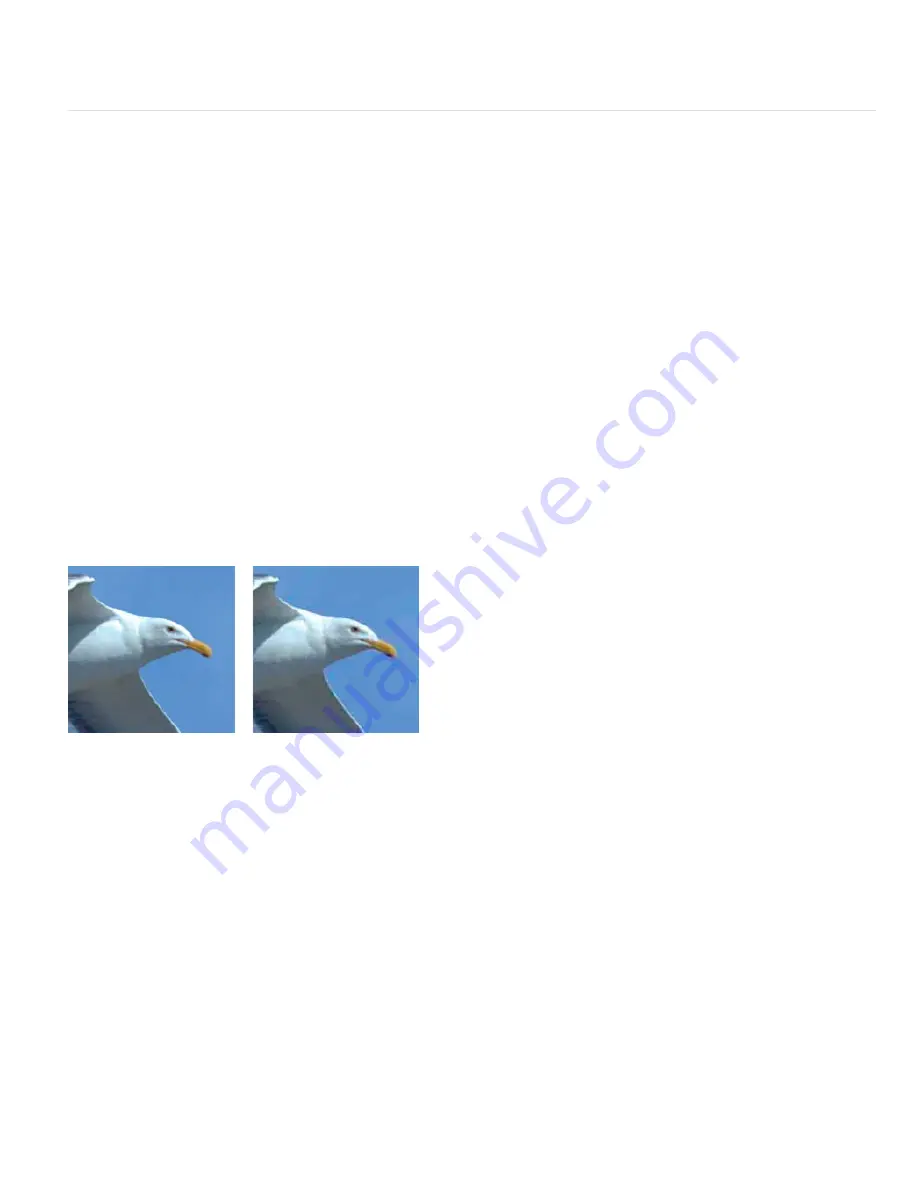
To the top
A small toolbox is located in the upper-left corner of the dialog box. To view different areas of an image, select the Hand tool and drag to bring
those areas into view. To zoom in on an image, select the Zoom tool and click in a view; then hold down Alt, and click again to zoom out.
(Alternatively, you can use the Zoom box at the bottom of the dialog box.) To create matte colors, use the Eyedropper Color tool.
Optimized file formats for the web
You can choose between four formats for the web. Use the following guidelines when choosing the format for your web image:
JPEG
In most cases, this is the best format in which to save photographs.
PNG
-
24
Like JPEG, this is a good format for photographs. Choose PNG
-
24 rather than JPEG only when your image contains transparency.
(JPEG does not support transparency; you must fill it with a matte color.) PNG
-
24 files are often much larger than JPEG files of the same image.
GIF
GIF is the format to use for line art, illustrations with large areas of solid color and crisp detail, and text. Also, if you want to export an
animated image, you must use GIF.
PNG
-
8
PNG
-
8 is a lesser-known alternative to GIF. Use it for the same purposes (except animation).
Images in GIF and PNG
-
8 formats, sometimes called
indexed-color images
, can display up to 256 colors. To convert an image to indexed-color
format, Photoshop Elements builds a color lookup table. If a color in the original image does not appear in the color lookup table, the application
either chooses the closest color in the table or simulates the color using a combination of available colors.
JPEG and PNG
-
24 files support 24
-
bit color, so they can display up to 16 million colors. Depending on the format, you can specify image quality,
background transparency or matting, color display, and the method a browser should use to display the image while downloading.
The appearance of an image on the web also depends on the colors displayed by the computer platform, operating system, monitor, and browser.
You may want to preview images in different browsers and on different platforms to see how they will appear on the web.
About the JPEG format
The JPEG format supports 24
-
bit color, so it preserves the subtle variations in brightness and hue found in photographs. A progressive JPEG file
displays a low-resolution version of the image in the web browser while the full image is downloading.
JPEG image compression is called lossy because it selectively discards image data. A higher quality setting results in less data being discarded,
but the JPEG compression method may still degrade sharp detail in an image, particularly in images containing type or vector art.
Note: Artifacts, such as wavelike patterns or blocky areas of banding, are created each time you save an image in JPEG format. Therefore, you
should always save JPEG files from the original image, not from a previously saved JPEG.
Original image (left), and optimized JPEG with Low quality setting (right)
The JPEG format does not support transparency. When you save an image as a JPEG file, transparent pixels are filled with the matte color
specified in the Save For Web dialog box. To simulate the effect of background transparency, you can match the matte color to the web page
background color. If your image contains transparency and you do not know the web page background color, or if the background is a pattern, you
should use a format that supports transparency (GIF, PNG
-
8, or PNG
-
24).
About the GIF format
The GIF format uses 8
-
bit color and efficiently compresses solid areas of color while preserving sharp details like those in line art, logos, or type.
You also use the GIF format to create an animated image and preserve transparency in an image. GIF is supported by most browsers.
The GIF format uses LZW compression, which is a lossless compression method. However, because GIF files are limited to 256 colors, optimizing
an original 24
-
bit image as an 8
-
bit GIF can subtract colors from an image.
Summary of Contents for 29180155 - Photoshop Elements 4.0
Page 1: ...ADOBE PHOTOSHOP ELEMENTS Help and tutorials...
Page 2: ...Getting started tutorials...
Page 6: ...What s new...
Page 13: ...Workspace and workflows...
Page 25: ...Legal Notices Online Privacy Policy...
Page 53: ...Importing...
Page 56: ...File management...
Page 69: ...Image adjustments...
Page 105: ...Legal Notices Online Privacy Policy...
Page 154: ...Legal Notices Online Privacy Policy...
Page 159: ...Selecting...
Page 175: ...Legal Notices Online Privacy Policy...
Page 181: ...Color...
Page 213: ...More Help topics Legal Notices Online Privacy Policy...
Page 220: ...Drawing and painting...
Page 229: ...More Help topics Legal Notices Online Privacy Policy...
Page 244: ...More Help topics Legal Notices Online Privacy Policy...
Page 258: ...Effects and filters...
Page 311: ...Legal Notices Online Privacy Policy...
Page 325: ...Text and shapes...
Page 340: ...More Help topics Legal Notices Online Privacy Policy...
Page 341: ...Layers...
Page 363: ...Printing and exporting...
Page 366: ...Legal Notices Online Privacy Policy...
Page 374: ...Photo projects...
Page 392: ...Web graphics...




























